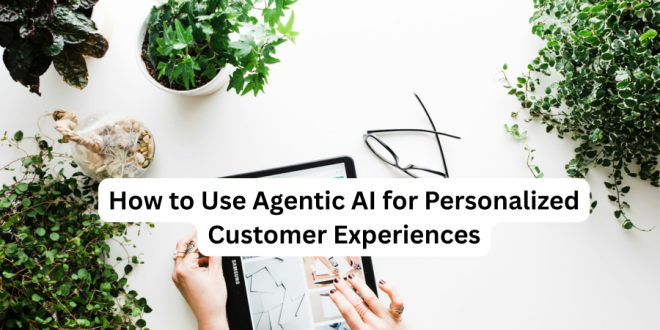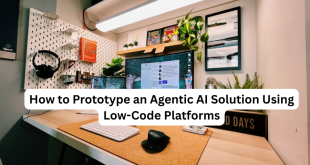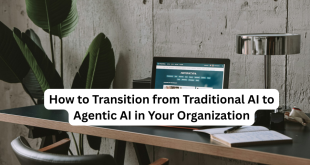In today’s competitive market, delivering personalized customer experiences is a game-changer for businesses of all sizes. Agentic AI—autonomous systems that make decisions and act independently—takes personalization to the next level by analyzing data in real time and tailoring interactions to individual preferences. From customized product recommendations to dynamic support, agentic AI can help small businesses build stronger customer relationships and boost loyalty. In this guide, we’ll walk you through how to use agentic AI to create personalized customer experiences, with practical steps and affordable tools.
Why Agentic AI for Personalization?
Unlike traditional AI, which follows predefined rules, agentic AI adapts dynamically to customer behavior, making it ideal for personalization. For example, it can analyze a customer’s purchase history, browsing patterns, and preferences to offer tailored suggestions or resolve issues faster. According to a 2023 McKinsey report, 71% of consumers expect personalized interactions, and businesses that deliver them can see up to 40% revenue growth. For small businesses, agentic AI offers a cost-effective way to meet these expectations without a large team.
Here’s how to get started.
Step 1: Identify Personalization Opportunities
Start by pinpointing where personalization can make the biggest impact in your business. Common areas include:
- E-commerce: Recommending products based on browsing or purchase history.
- Customer Support: Offering tailored solutions by analyzing past interactions.
- Marketing: Sending personalized emails or ads based on customer interests.
Action Item: Choose one area to focus on. For example, “Increase e-commerce sales by suggesting products tailored to each customer.” Define a measurable goal, like a 20% increase in click-through rates.
Step 2: Select the Right Agentic AI Tools
You don’t need a big budget to leverage agentic AI. Several affordable, user-friendly platforms can help small businesses build personalized experiences:
- Cloud-Based AI Platforms:
- Google Cloud AI: Offers tools like Recommendations AI for product suggestions and Contact Center AI for personalized support.
- Microsoft Azure AI: Provides personalization APIs and Cognitive Services for analyzing customer data and tailoring interactions.
- Customer Relationship Management (CRM) Tools with AI:
- HubSpot: Integrates AI to personalize email campaigns and customer journeys with minimal setup.
- Salesforce Einstein: Uses AI to predict customer needs and automate personalized marketing.
- Open-Source Options:
- Hugging Face: Offers pre-trained models for natural language processing (NLP), which can be fine-tuned for personalized chatbots or content.
- Apache Mahout: A framework for building recommendation systems, ideal for e-commerce.
Action Item: Pick a tool that aligns with your technical skills and budget. For beginners, try HubSpot’s free tier or Google’s Recommendations AI, which offers a pay-as-you-go model. Test a free trial to ensure it fits your needs.
Step 3: Gather and Organize Customer Data
Agentic AI thrives on data to deliver personalized experiences. Collect relevant data from your existing systems, such as:
- Purchase History: What products or services customers have bought.
- Browsing Behavior: Pages visited, items added to carts, or time spent on your site.
- Customer Interactions: Support tickets, chatbot conversations, or email responses.
- Demographics: Age, location, or preferences shared via forms.
Best Practices:
- Use tools like Google Analytics or Shopify’s analytics for e-commerce data.
- Ensure compliance with data privacy laws like GDPR or CCPA by obtaining consent and anonymizing data.
- Store data in a centralized system, like a CRM or cloud database, for easy access.
Example: A small online bookstore used Shopify to track which genres customers browsed and purchased. This data fed into an AI recommendation system, boosting sales by 15% in three months.
Action Item: Audit your current data sources and set up a system to collect missing data, like adding a preference form to your checkout process. Aim for clean, structured data to train your AI effectively.
Step 4: Build and Deploy Your Agentic AI Solution
Now, create a minimum viable product (MVP) to test your personalization strategy. Here’s how to do it:
- Choose a Model: Select a pre-built AI model from your platform. For example, use Google’s Recommendations AI for product suggestions or HubSpot’s AI for email personalization.
- Train the Model: Feed it your customer data. For instance, upload purchase histories to train a recommendation engine or past support tickets for a smarter chatbot.
- Test Performance: Run small tests to check accuracy. Does your recommendation system suggest relevant products? Does your chatbot resolve queries effectively?
- Deploy: Integrate the AI into your customer touchpoints, like embedding a recommendation widget on your website or automating emails through your CRM.
Pro Tip: Start with one channel, like your website or email campaigns, to keep things manageable. Expect 2–4 weeks to build and test your MVP.
Action Item: Follow your platform’s setup guide (e.g., Google’s Recommendations AI tutorials) to deploy your MVP. Test it with a small customer segment before a full rollout.
Step 5: Monitor and Optimize for Better Results
Personalization improves with continuous refinement. Monitor your AI’s performance and gather feedback to ensure it delights customers.
- Track KPIs: Measure metrics like conversion rates, customer satisfaction scores, or email open rates. For example, did your recommendation system increase average order value?
- Analyze Feedback: Ask customers for input via surveys or monitor social media for reactions to your AI-driven interactions.
- Refine the Model: Use new data to retrain your AI, improving its accuracy. Most platforms, like Salesforce Einstein, automate this process.
Example: A boutique clothing store used HubSpot to send personalized emails. After noticing low open rates, they adjusted the AI to prioritize recent browsing data, increasing opens by 25%.
Action Item: Set up weekly or monthly reviews using your platform’s analytics dashboard. Schedule time to retrain your model with fresh data every 1–2 months.
Step 6: Ensure Ethical Personalization
Personalization must balance relevance with respect for privacy. Avoid “creepy” experiences by following ethical guidelines:
- Be Transparent: Inform customers when AI is used, e.g., “Our AI suggests products based on your browsing.”
- Respect Privacy: Only use data customers consent to share, and provide opt-out options.
- Avoid Bias: Regularly audit your AI to ensure it doesn’t favor certain customer groups unfairly.
Action Item: Add a privacy statement to your website or emails explaining how you use AI. Use your platform’s compliance tools (e.g., Azure’s data governance features) to stay aligned with regulations.
Step 7: Scale Personalization Across Channels
Once your MVP succeeds, expand personalization to other areas of your business:
- Omnichannel Experiences: Sync AI across your website, mobile app, social media, and support channels for a cohesive customer journey.
- Advanced Features: Add capabilities like real-time personalization (e.g., dynamic website content) or predictive analytics to anticipate customer needs.
- Integrate Systems: Connect your AI to other tools, like linking your recommendation engine to your CRM for richer insights.
Example: A coffee shop started with AI-driven email offers via HubSpot. After success, they added a chatbot on their website, using the same customer data to suggest drinks, increasing online orders by 20%.
Action Item: Create a three-month plan to expand personalization, starting with one new channel or feature. Check your platform’s integrations to simplify scaling.
Start Personalizing with Agentic AI Today
Agentic AI makes personalized customer experiences accessible, even for small businesses. By leveraging affordable tools, clean data, and a focused strategy, you can build stronger connections with customers and drive growth. Here’s a quick recap:
- Identify a high-impact personalization opportunity.
- Choose user-friendly tools like HubSpot or Google Cloud AI.
- Collect and organize customer data ethically.
- Build and deploy a simple AI solution.
- Monitor and optimize based on performance.
- Prioritize transparency and privacy.
- Scale personalization across channels.
Ready to wow your customers? Sign up for a free trial of HubSpot or Google Cloud AI and start experimenting with personalized recommendations or support. With agentic AI, you can deliver the tailored experiences customers crave, all while saving time and resources.
 UBUCH ubuch | Honest Tech Reviews & Tutorials for Everyone
UBUCH ubuch | Honest Tech Reviews & Tutorials for Everyone




